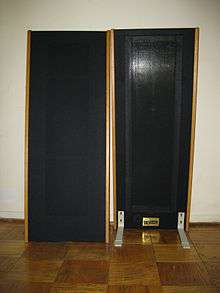Magnepan

Magnepan is a private high end audio loudspeaker manufacturer in White Bear Lake, Minnesota, United States. Their loudspeaker technology was conceived and implemented by engineer Jim Winey in 1969.
Overview
Magnepan's speaker design, sold under the brand name Magneplanar (often referred to as "Maggies" in the industry), differs from that of conventional speakers in relying not on cones mounted in an enclosure but on a planar driver system mounted in a panel. A Magneplanar's reproducing mechanism comprises thin conductive wires and or foil strips attached to a thin sheet of Mylar residing in a magnetic field created by a vertical array of permanent strip magnets. When an amplified signal is applied to the conductors, the resultant electrical forces react with the magnetic field to excite the Mylar film sheet, which projects sound as a dipole. In principle, this approach relies on the same concept as a voice coil-driven cone speaker, but in a Magneplanar speaker the "voice coils" are attached (glued) directly to the radiating surface.

Sound is projected from both the front and back of the radiating surface. The sound from the back of the speaker is reflected from the front wall of the listening area. This is said to effectively enhance the soundstage - the sense of space and realism - of the speaker. The Magneplanar design, using a passive magnet array, is not a unique loudspeaker implementation, although it was the first of its type. Eminent Technology, Analysis Audio, and others also employ passive magnet designs. Broadly, these are classed as planar-magnetic speakers.
There are other similar speaker designs to the Magneplanar. Martin-Logan and Quad Electroacoustics, among others, make electrostatic loudspeakers, which are another variation on the dipole model. Electrostatic speakers operate on a somewhat different principle. While the voice coils in the Magneplanar are conductive wires or foil strips mounted on a sheet of Mylar film, electrostatic speakers suspend a charged conductive film between two grids (stators) which move the film. One disadvantage of both designs is that a very large panel is required to produce deep bass. Magnepan has addressed this via the physical size of the speakers - a physically large radiating surface produces more bass. Martin-Logan has addressed the bass problem by mounting a conventional cone bass driver in a separate section of the speaker chassis, generally resulting in a physically smaller speaker than the Magneplanar.
The most frequently cited disadvantages of the overall design are relatively low efficiency and, given the absence of an enclosure, extreme difficulty in reproducing very low bass frequencies.
Models
| Model | Type | Technology | Freq. Response | Sensitivity | Impedance | Size | Production Years |
|---|---|---|---|---|---|---|---|
| Magneplanar MMG | Floor Stander | 2-Way / Quasi-Ribbon Planar-Magnetic | 50 Hz-24 kHz +/- 3db | 86db / 500 Hz / 2.83v | 4 ohm | 14.5 x 48 x 1.25 inches | 1995–Present |
| Magneplanar 1.7 | Floor Stander | 3-Way, Full-Range, Quasi-Ribbon | 40 Hz-24 kHz | 86db / 500 Hz / 2.83v | 4 ohm | 19 x 65 x 2 inches | 2010–Present |
| Magneplanar 3.7i | Floor Stander | 3-Way, Full-Range, Ribbon Tweeter | 35 Hz-40 kHz | 86db / 500 Hz / 2.83v | 4 ohm | 24 x 71 x 1.625 inches | 2013–Present |
| Magneplanar 20.7 | Floor Stander | 3-Way / Ribbon Tweeter - Planar-Magnetic | 25 Hz-40 kHz | 86db / 500 Hz / 2.83v | 4 ohm | 29 x 79 x 2.062 inches | 2011–Present |
References
Interviews
- Jim Winey: Maggie's Man in Stereophile, January 2003